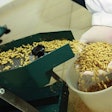On Dec. 28, 2010, the Chinese Ministry of Commerce (MOFCOM) began an anti-dumping investigation into the import of distiller's dried grains with or without solubes (DDG(S)) originating from the United States.
Production of the feed co-product, which is derived from corn during the ethanol making process, has increased steadily in the United States over the past three years. Meanwhile, China’s need for high-protein feed ingredients has increased sharply, so livestock producers boosted their U.S. DDGS purchases. As a result, shipments to China shot up from almost nothing in 2008 to more than 2 million metric tons in 2010.
Four Chinese DDGS manufacturers, who represent half of the domestic industry, claim they have lost significant sales due to the surge in U.S. origin DDGS sold at lower than market prices, and initiated an anti-dumping investigation.
In response to the investigation, the U.S. Grains Council, the organization responsible for developing export markets for U.S. barley, corn, grain sorghum and related products, has coordinated an industry-wide registration process for interested parties. The deadline for registering was Jan. 17, and 68 companies registered with the council. The MOFCOM has begun investigating a sample of these interested companies and will issue a final determination on Dec. 28, one year from its start date.
If the Chinese government concludes based on their investigation that the United States is indeed dumping DDGS, it would impose punitive tariffs on imports of U.S. DDGS to China.
Provisional tariffs on DDGS could begin as early as June 2011. China is expected to make a decision on its findings by Dec. 28, but the deadline may be extended by six months if needed.
Rebecca Bratter, USGC director of trade development, sat down with Feed & Grain to answer questions about the basis of the case, the MOFCOM’s method of investigation, and the potential outcomes and their impact on U.S. DDGS producers.
F&G: What is the basis of the dumping claim being made by the domestic Chinese DDGS industry?
Bratter: China hadn’t made any significant purchases of corn from the United States, or anywhere, since 1995, and in the last year it bought 1.4 million metric tons of corn and nearly 3 million metric tons of DDGS.
That is a pretty significant ramp up in a very short time period. Anytime you see imports of a product go from 0 to 3 million metric tons, it can trigger an investigation like this one. When a nation lodges an anti-dumping investigation, they’re saying they believe the sale of your product is injuring their domestic industry and causing financial harm.
F&G: The USGC responded by helping U.S. companies register as interested parties. What does being an interested party mean, and why was it advantageous for U.S. DDGS producers to do so?
Bratter: Companies that registered as an interested party are willing to cooperate in the investigation. Interested parties may or may not be chosen to be investigated for dumping.
Sixty-eight DDGS exporters registered through the USGC, and about 10 other companies registered on their own. It’s in the company’s best interest to register because they can qualify for lower, negotiated tariffs.
When the Chinese start to assess duties, whether they’re preliminary — meaning during the course of the investigation — or in the final determination, there are different levels of duties assessed. One level goes to interested parties, which on a preliminary basis will be more favorable than if you were a non-interested party. Companies not registered as an interested party will be in a category called “all others,” which is subject to the highest possible tariff rate.
F&G: How will the Chinese government investigate the interested parties in the United States?
Bratter: The case will proceed on two tracks, a dumping investigation covering the period from July 1, 2009, to June 30, 2010, and an investigation of injury to the local industry during the period from Jan. 1, 2007, to June 30, 2010. The entire industry is investigated for injury, but only a sampling of firms is investigated for dumping.
After the registration process was complete, Chinese authorities began a fact-finding process that includes investigations of specific company practices. MOFCON will draw information about company practices from a series of questionnaires that the registered interested parties completed. The USGC hired legal counsel and responded to the injury questionnaire on behalf of the entire industry.
A sampling methodology was used to choose the firms being investigated for dumping. MOFCON chose three companies and one was disqualified, so they will continue investigating the other two selections.
F&G: What are some potential outcomes of the MOFCOM investigation and what is the USGC doing to facilitate a positive ruling?
Bratter: The best possible outcome would be the Chinese government finds no evidence of injury and the case is thrown out. The worst possible outcome would be finding of injury and dumping, which would result in high tariffs for U.S. DDGS exporters.
Our sense is this case may be a way for the Chinese to learn about the complexities of the DDGS industry in the United States and get to know the buyers in China. The USGC intends to operate as normal in China and continue our trade relationship despite whatever happens in this case.
Right now, we’re working with lawyers to ensure we have enough information to make concrete statements about why we believe this situation is the normal flow of trade, and not necessarily dumping. Our goal is to encourage a resolution that focuses on the long-term U.S.-China trade relationship.


















